Just when I think my interest in Kyoto has peaked, the city gives me even more reasons to love it. The only downside is that the thought of leaving this place, a looming and inevitable affair, grows more painful with each day.
This morning, I got up at 6, a relatively reasonable time for me — at least I know that my body is adjusting to Japanese time. Franky and I went to a supermarket to buy souvenirs (in my case, an absurd amount of instant ramen) and Otero Pan, a bakery I had difficulty finding the day before. The chocolate croissant I had was delicious — it was flaky, buttery, and surprisingly moist.
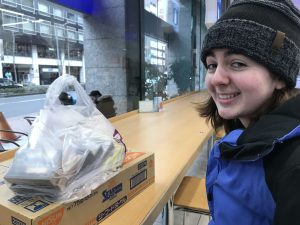
Frankie and my noodles.
After dropping off the goods at the hostel, we joined the rest of the group and proceeded to the Noh performance, which lasted from 11 AM to 5 PM. I felt a bit more prepared with the research I’ve done beforehand and Monica Bethe’s lecture yesterday morning, but I still did not know what to fully expect. I had most of the puzzle pieces but still had to fit them together, if you will. After the final round of applause, I was surprised by what came out of this six-hour performance cum marathon.
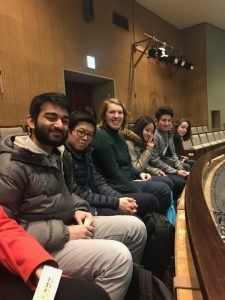
The group (plus Joanne’s arm) before the seat change and performance!
The empty stage was the first thing that caught my eye. Reconstructing a temple inside the hall while still alluding to the genre’s natural and outdoor origins was achieved quite harmoniously, from the dark green upper walls to the thin pine trees that lined the bridge. Once the performance began, my eyes were mesmerized by the actors’ costumes, which came in such vivid colors and patterns. Saying they were a feast for the eyes is an understatement — it was as if I saw painting after painting come alive on stage. The juxtapositions within the garment/s of each person and between people is a testament of the skill and eye necessary to execute these successfully.
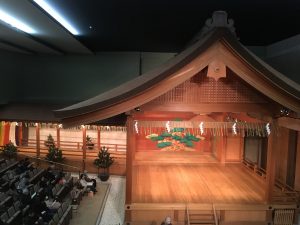
The Noh stage.
Understanding the historical origins of Okina, the first Noh play (though this word is more a misnomer), allowed me to see it in a ritualistic light. There was a procession beforehand, which was then followed with a sight I had never experienced before. The plot and sounds took a while to get used to, but once I did, the plays became enjoyable. My favorite portion was Toboku, the women Noh play surrounding the plum garden favored by Izumi Shikibu. There was a poetic tenderness that was less pronounced in the plays that preceded and followed it.
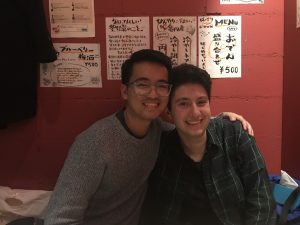
Leah and me, happily stuffed.
The group split ways after the performance ended. Leah, Sohum, and I ended up on Kawaramachi-doji for shopping. We visited Loft, which had a mind-boggling stationery section, and then Uniqlo, which is one of my favorite places to shop! Yay for affordable basics. We ate at a tempura restaurant across from our hostel (the name of which I cannot remember) and were satisfied by the selections. We all got the multi-course meal, which began with an assortment of appetizers and ended with cold udon and a soft-boiled egg, a refreshing finale to a delicious meal.
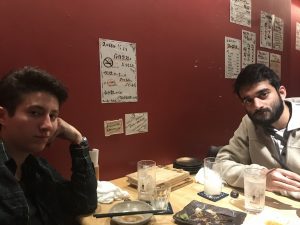
Leah and Sohum, my cheery dinner companions.
I’m quite excited to meet the Takabayashi family and to visit Arashiyama tomorrow!

